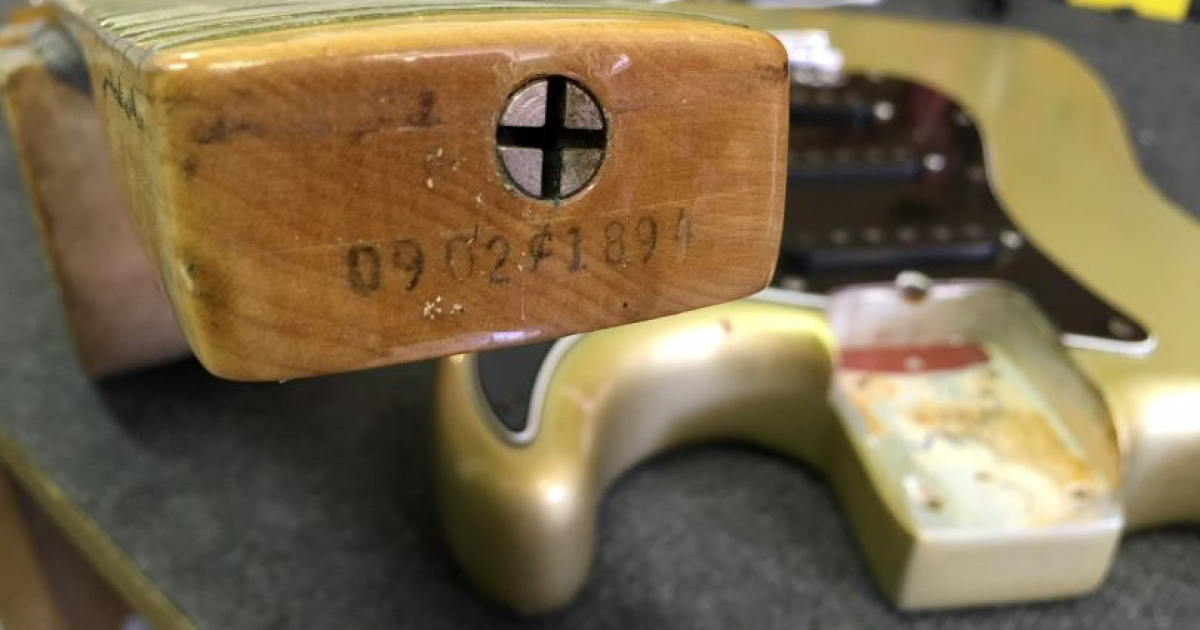

The years overlap a lot, therefore serial numbers, in fact, only serve as an essential guide. Usually, the numbers are in chronological order, but it’s not a rule.
Fender guitar serial number dating serial numbers#
From the beginning of Fender production until 1977, serial numbers are always stamped either on the bridge or a plate on the back of the body.

Nowadays, you may find it on the back of the headstock. On Japanese Fenders from the ’80s and ’90s, the serial number is on the back of the neck, just a little apart from the guitar body.

Years later, serial numbers appear on the headstock near the Fender logo. The first Fenders had their serial numbers stamped on the bridge later, the number was imprinted on the plate between the screws in the neck/body joint. However, these facts may only be discovered after a thorough inspection. At first glance, pickups or potentiometers may look the same but by checking their age, you may find that their date of manufacture is, for example, ten years later than the rest of the guitar. The dating will often testify whether the individual guitar parts are original or altered. In such cases, do not be fooled and check the date of the individual guitar parts and determine the actual age and value of the instrument accordingly.

It’s common that a dealer somewhere in the world offers a guitar from a particular year and refers to its serial number. Therefore, because of the difference in the age of the parts, the price is difficult to be determined. But if you owned the same model just a year or a few years older, it would have been even higher. If you have a 1956 Fender Telecaster at home, its price is high. With each earlier year of production, the price of these guitars goes up. The dating of Fenders from the 1950s and the first half of the 1960s is significant for one simple reason. The same thing happened with other parts, too. Thus, in 1966 Fender bought a large batch of potentiometers that were dated the same year of manufacture but were then used for guitars over the next few years. It is common to find that a part was made in a particular year (which was also written on it) but there was a four-year difference with the rest of the guitar. But this fact often poses a problem for future researchers who will be puzzling over exact dating. Fender had many parts in the factory in large quantities because it’s good to have multiple pieces of products and parts in stock if needed. So if you take this guitar apart thoroughly, you’ll find more relevant data than just a general range of production years by a serial number.īut there are pitfalls here, too. This is because they are made up of dozens of parts-and most importantly, they don’t have necks glued to the body. Sometime during those years, the guitar was actually manufactured and then released into the world.ĭating Fender guitars is a rewarding task. If you enter a serial number of a guitar from the 1970s, for example, into a decoder, the result is usually a range of two to three years. While there are databases of serial numbers, many of them show just a particular period. The most relevant reference is a serial number, which indicates a general period rather than a specific year. The correct information should instead provide a specific time range. Therefore, it is sometimes misleading when a particular year is presented as the date of origin with old guitars. What exactly does the serial number and dating indicate?īecause manufacturing is a lengthy process and different manufacturers often produce individual parts in large quantities, it is common for the dating on various parts of a single guitar to vary by several years. Often it is a combination of all options. Markings have been done over the years either by handwriting, stamping, or imprinting on metal parts of the hardware.
Fender guitar serial number dating how to#
Fortunately, nowadays, there are comprehensive databases of serial numbers and guides on how to date guitars correctly. However, the method of dating has changed several times over the years. Fender has dated its guitars since the beginning of its production. It’s a logical procedure because one needs to keep track of everything. Manufacturing with serial numbers and dates is also commonly used in industries other than guitar making.


 0 kommentar(er)
0 kommentar(er)
